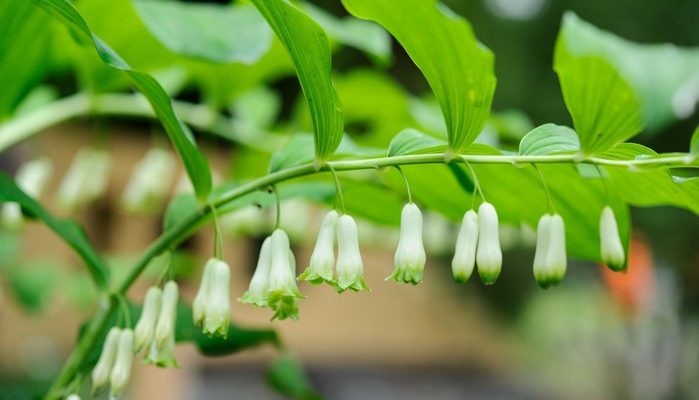Table of Contents
Beginner Garden for Shade
How to grow and care of Solomon’s Seal. This easy-to-care-for shade garden is lovely in all seasons, but especially during late winter and spring.
Witch hazel and astilbe bloom early in the season, adding a touch of cheerfulness. Hosta and Solomon’s seal have striking leaves that keep the garden looking good even when the flowers aren’t blooming.
Colorful Combinations
These plants are the perfect backdrop for other shade-loving perennials in the garden because of their clean green foliage. New sprouts of Solomon’s seal emerge in early spring and are ornamental in their own right, resembling green wands that wave playfully in the breeze. In some varieties, this new growth is flushed gray purple, which enhances the whole effect.
Solomon’s seal blossoms come in a few colors, the most common being white with green tips. A few rarer species offer blooms in purple, pink, or orange. The flowers are often pleasantly fragrant. After the blooms fade, berries appear in their place. These berries start out green and turn purple-blue as they ripen, eventually turning black. They’re poisonous to humans but birds love them.
Solomon’s Seal Care
Solomon’s seals are easy to grow and prefer rich soil that is full of organic matter, has lots of moisture, and is in a shady spot. They are able to survive short droughts, but during longer dry periods they will appreciate extra water.
Because of their preference for shade, Solomon’s seal plants are often found in areas where there is dappled light or full shade, such as beneath large trees. They can tolerate full shade well, but may appear thinner and less robust.
In the fall, the leaves of Solomon’s seal turn a beautiful golden color, which is best shown off when some sunlight can reach the plant. If you’re planting them in an area with direct sun, they’ll do better in cool morning sun than in hot afternoon sun.
Solomon’s seals are tough plants that can spread quickly through their underground stems, called rhizomes.
You can divide the rhizomes in early spring or fall to create more plants, which is simple to do – just dig up the plants and carefully separate the rhizomes, making sure each division has several growing points. This ability to easily multiply makes them great for containment purposes if you don’t want them taking over your garden!
A Collector’s Plant
There are many different types of Solomon’s seal that are perfect for shade gardens. Variegated selections are especially beautiful, and there is a wide range of plant sizes available. You can find dwarf forms that are less than six inches tall, and varieties up to 12 feet tall. These varieties can be pricey and typically aren’t found at commercial garden centers, so check online or at local specialty nurseries.
More Varieties of Solomon’s Seal
Common Solomon’s Seal
Polygonatum x hybridum is a beautiful plant that features gently arching stems with dangling pairs or clusters of cream flowers in late spring. This plant is perfect for gardens that are looking for a bit of extra color in late spring and early summer.
Additionally, the stout rhizomes of this plant are drought tolerant and colonize well, making it a great choice for gardeners who want a plant that is easy to care for. Polygonatum x hybridum may reach 5 feet tall and is hardy in zones 3-8.
Variegated Fragrant Solomon’s Seal
Polygonatum odoratum ‘Variegatum’ is a beautiful plant that features creamy-edged alternate leaves, and usually pairs of stunning creamy bells. It typically grows to be 3-4 feet tall, is very drought tolerant, and hardy in Zones 3-8.
Plant Solomon’s Seal With:
Bleeding heart
The bleeding heart plant gets its name from its heart-shaped blooms that are pink or white in color. This plant thrives best when it is grown in partial to full shade in moist, well-drained soil. Some types of bleeding heart only bloom in the spring, while others can bloom in the spring, summer, and fall if temperatures are not too high.
Lungwort
Early in the spring, when other plants are still dormant, the beautiful blue, pink, or white flowers of lungwort appear.
These cheerful flowers are a welcome sign that warmer weather is on the way. The tough, spotted or plain leaves of lungwort stay attractive all year long and make this plant a valuable addition to the garden as a weed-discouraging ground cover, border edging, or bright accent plant. Lungworts prefer a high-humus soil that retains moisture, but they are tolerant of dry conditions. Be on the lookout for mildew, though, which can be a problem in humid conditions.
Columbine
Columbines are ideal for cottage and woodland gardens, and come in a wide range of colors. Usually a combination of red, peach, and yellow, they can also bloom in blues, white, pure yellow, and pink. They have intricate little flowers that resemble folded paper lanterns.
Columbines need moist, well-drained soil to thrive, and can grow in sun or partial shade. They tend to be short-lived but self-seed readily, often creating natural hybrids with other nearby columbines. To prevent self-seeding, deadhead them after blooming.
Coralbells
Coralbells are enjoying newfound popularity due to their exciting foliage patterns. Once grown mainly for their dainty, reddish flowers, coralbells are now also grown for the unusual mottling and veining of their different-colored leaves.
The low clumps of long-stemmed evergreen or semi-evergreen lobed foliage make coralbells an excellent ground cover plant. They enjoy humus-rich, moisture-retaining soil; however, beware of heaving in areas with very cold winters.



